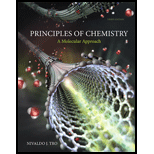
Determine whether or not each redox re action occurs spontaneously in the reverse direction.
a.
b.
c.
d.
Want to see the full answer?
Check out a sample textbook solution
Chapter 18 Solutions
Principles of Chemistry: A Molecular Approach (3rd Edition)
- Consider the following galvanic cell: Calculate the concentrations of Ag+(aq) and Ni2+(aq) once the cell is dead.arrow_forward1. If you wish to convert 0.0100 mol of Au3+ (aq) ions into Au(s) in a “gold-plating” process, how long must you electrolyze a solution if the current passing through the circuit is 2.00 amps? 483 seconds 4.83 104 seconds 965 seconds 1450 secondsarrow_forwardFour metals, A, B, C, and D, exhibit the following properties: (a) Only A and C react with 1.0 M hydrochloric acid to give H2(g). (b) When C is added to solutions of the ions of the other metals, metallic B, D, and A are formed. (c) Metal D reduces Bn+ to give metallic B and Dn+. Based on this information, arrange the four metals in order of increasing ability to act as reducing agents.arrow_forward
- An electrolytic cell is set up with Cd(s) in Cd(NO3)2(aq) and Zn(s) in Zn(NO3)2(aq). Initially both electrodesweigh 5.00 g. After running the cell for several hours theelectrode in the left compartment weighs 4.75 g. (a) Which electrode is in the left compartment? (b) Does the mass of the electrode in the right compartmentincrease, decrease, or stay the same? If the masschanges, what is the new mass? (c) Does the volume of the electrode in the right compartment increase, decrease, or stay the same? If the volumechanges, what is the new volume? (The density of Cd is8.65 g/cm3.)arrow_forwardConsider the following cell running under standard conditions: Fe(s)Fe2+(aq)Al3+(aq)Al(s) a Is this a voltaic cell? b Which species is being reduced during the chemical reaction? c Which species is the oxidizing agent? d What happens to the concentration of Fe3+(aq) as the reaction proceeds? e How does the mass of Al(s) change as the reaction proceeds?arrow_forwardMany oxidationreduction reactions can be balanced by inspection. Try to balance the following reactions by inspection. In each reaction, identify the substance reduced and the substance oxidized. a. Al(s) + HCl(aq) AlCl3(aq) + H2(g) b. CH4(g) + S(s) CS2(l) + H2S(g) c. C3H8(g) + O2(g) CO2(g) + H2O(l) d. Cu(s) + Ag+(aq) Ag(s) + Cu2+(aq)arrow_forward
- An aqueous solution of an unknown salt of gold is electrolyzed by a current of 2.75 amps for 3.39 hours. The electroplating is carried out with an efficiency of 93.0%, resulting in a deposit of 21.221 g of gold. a How many faradays are required to deposit the gold? b What is the charge on the gold ions (based on your calculations)?arrow_forwardWrite balanced equations for the following half-reactions. Specify whether each is an oxidation or reduction. (a) H2O2(aq) O2(g)(in acid) (b) H2C2O4(aq) CO2(g)(in acid) (c) NO3(aq) NO(g)(in acid) (d) MnO4(aq) MnO2(s)(in base)arrow_forwardDescribe what you expect to happen when the following solutions are electrolyzed: a aqueous Na2SO4; b aqueous KBr. That is, what are the electrode reactions? What is the overall reaction?arrow_forward
- Draw a diagram of each cell. Label the anode, the cathode, the species in each half-cell solution, the direction of electron movement in an external circuit, and thedirection of movement of ions within the cell. (a) Cu(s) | Cu2+(aq) || Fe2+(aq) |Fe(s) (b) Pt(s) | H2O2(aq), H+(aq) || Fe2+(aq), Fe3+(aq) | Pt(s)arrow_forwardThe Toliens test for the presence of reducing sugars (say, in a urine sample) involves treating the sample with silver ions in aqueous ammonia. The result is the formation of a silver mirror within the reaction vessel if a reducing sugar is present. Using glucose, C6H12O6, to illustrate this test, the oxidation-reduction reaction occurring is C6H12O6 (aq) + 2 Ag+(aq) + 2OH(aq) C6H12O7(aq) + 2 Ag(s) + H2O() What has been oxidized, and what has been reduced? What is the oxidizing agent, and what is the reducing agent? Tolien's test. The reaction of silver ions with a sugar such as glucose produces metallic silver. (a) The set-up for the reaction. (b) The silvered test tubearrow_forwardA factory wants to produce 1.00 103 kg barium from the electrolysis of molten barium chloride. What current must be applied for 4.00 h to accomplish this?arrow_forward
 Chemistry: The Molecular ScienceChemistryISBN:9781285199047Author:John W. Moore, Conrad L. StanitskiPublisher:Cengage Learning
Chemistry: The Molecular ScienceChemistryISBN:9781285199047Author:John W. Moore, Conrad L. StanitskiPublisher:Cengage Learning Chemistry & Chemical ReactivityChemistryISBN:9781337399074Author:John C. Kotz, Paul M. Treichel, John Townsend, David TreichelPublisher:Cengage Learning
Chemistry & Chemical ReactivityChemistryISBN:9781337399074Author:John C. Kotz, Paul M. Treichel, John Townsend, David TreichelPublisher:Cengage Learning Chemistry & Chemical ReactivityChemistryISBN:9781133949640Author:John C. Kotz, Paul M. Treichel, John Townsend, David TreichelPublisher:Cengage Learning
Chemistry & Chemical ReactivityChemistryISBN:9781133949640Author:John C. Kotz, Paul M. Treichel, John Townsend, David TreichelPublisher:Cengage Learning ChemistryChemistryISBN:9781305957404Author:Steven S. Zumdahl, Susan A. Zumdahl, Donald J. DeCostePublisher:Cengage Learning
ChemistryChemistryISBN:9781305957404Author:Steven S. Zumdahl, Susan A. Zumdahl, Donald J. DeCostePublisher:Cengage Learning Chemistry: An Atoms First ApproachChemistryISBN:9781305079243Author:Steven S. Zumdahl, Susan A. ZumdahlPublisher:Cengage Learning
Chemistry: An Atoms First ApproachChemistryISBN:9781305079243Author:Steven S. Zumdahl, Susan A. ZumdahlPublisher:Cengage Learning





